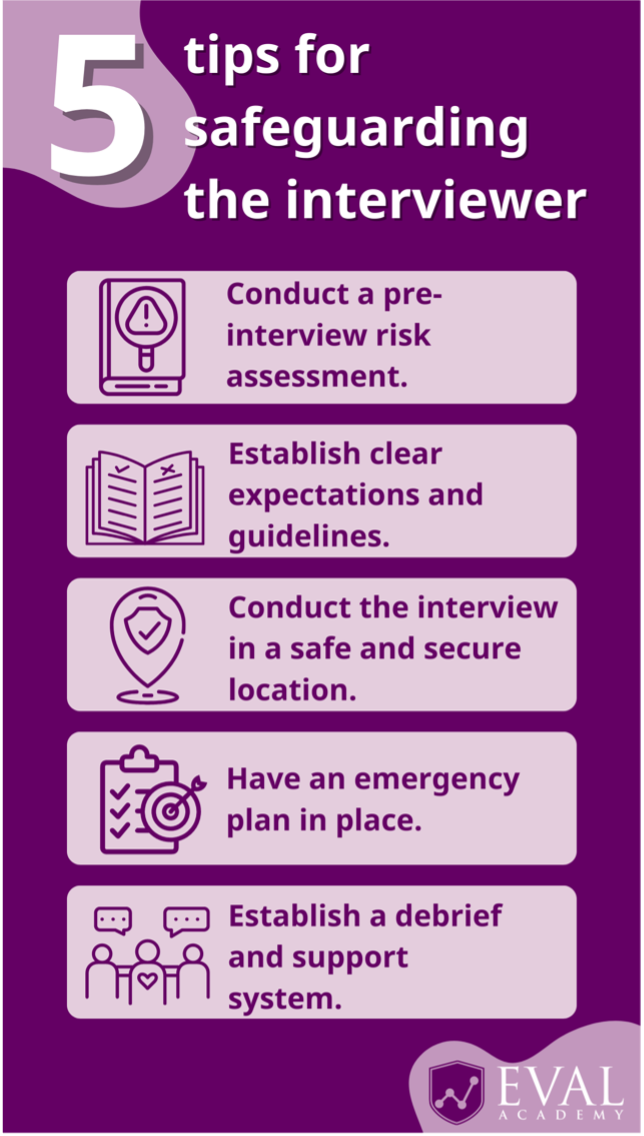This is an Eval Central archive copy, find the original at evalacademy.com.
This article is rated as:


At Eval Academy, we’ve discussed the importance of ethical practice when collecting qualitative data including obtaining consent and maintaining confidentiality and anonymity. Many of our previous conversations have focused on the need to ensure the safety and well-being of participants.
In this article, we highlight the importance of also ensuring interviewer safety to make the interview experience effective for collecting data and a positive experience for everyone involved! Here are our 5 tips for safeguarding the interviewer:
1. Conduct a pre-interview risk assessment.

Before starting your interviews, it’s important to assess potential psychological risks associated with the discussion topic or participant characteristics. Take some time to evaluate factors such as sensitive topics, the possibility for emotional distress, or power dynamics that might arise during the interview process. This assessment will help you to identify potential challenges that might occur and provide you with the opportunity to develop strategies to address them. If you work as part of a team, engage them in a discussion about potential psychological concerns you have, including any personal impacts or triggering situations you might find yourself in.
2. Establish clear expectations and guidelines.
The purpose, scope, and expectations of the interview process should be clearly communicated to participants before they consent to take part. This includes sharing information on the topics that will be covered. As well as knowing the purpose of the interviews, participants should be fully aware of their rights, confidentiality measures, and the voluntary nature of the interviews. Sharing documentation beforehand in a way that is appropriate to your participants will manage their expectations for the session and allow you to establish guidelines for respectful communication, confidentiality, and appropriate behaviour throughout the interview process.
3. Conduct the interview in a safe and secure location.
Prior to the interview, take time to assess the physical risk and safety of the interview location. Choose a location that ensures the safety and privacy of both you, the interviewer, and the participant. If completing the interviews virtually, ensure you have access to a quiet and private location where you can easily access any documentation and support systems you might need. For virtual interviews, encourage the participant to take the call in a location where they can have some privacy. If conducting in-person interviews, select a neutral and comfortable space that allows for confidential conversations.
If you are not able to select the location of the interview, assess the context of the location to examine how much you know about where you will be conducting the interview and other safeguards that can be taken. This includes ensuring there is an available staff member to check in on the interview periodically, ensuring you’re aware of exit points and doorways, assessing the space for objects that could be used as weapons, and knowing how to navigate the neighbourhood safely. During the interview itself, be prepared to take note of what the participant is wearing and how they’re positioning themselves, as well as anyone else who is at the location.
4. Have an emergency plan in place.
Based on your pre-interview risk assessment, you should prepare for potential emergencies or distressing situations.
An emergency plan for the interviewer: Identify your own emergency contact, such as the project leader. It can be useful to make a list of potential scenarios that might arise from the interviews and develop an action plan of how you would address them. Be prepared to respond calmly and compassionately in distressing situations.
An emergency plan for participants: Develop an emergency plan that includes contact information for relevant authorities or support services for participants. Familiarize yourself with appropriate resources such as helplines or counselling services and be prepared to provide this information to participants if they require assistance. Printing this information on handouts can ensure it is easily accessible to participants.
5. Establish a debrief and support system.
Don’t be afraid to ask for support! Recognize that conducting interviews, particularly on sensitive topics, can affect the emotional well-being of both interviewers and participants. Establish a debriefing process with a colleague or a mental health professional to create space to discuss any challenges, emotional impact, or concerns.
As interviewers, it’s our responsibility to prioritize the safety, well-being, and ethical inclusion of participants. By conducting a pre-interview assessment, setting clear expectations, assessing the physical risk and safety of the interview location, having an emergency plan in place and knowing how to use it, and establishing support systems, we can ensure the interview process is respectful, ethical, and valuable for everyone involved.
For more information and resources on conducting interviews, check out: